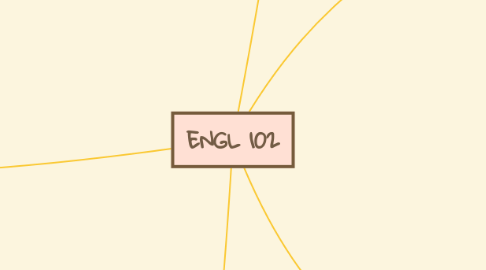
1. Reflection and Revision
1.1. 3A. adapt composing and revision processes for a variety of technologies and modalities
1.1.1. The groupwork case study we did allowed us to all work on our own computers, drafting a paper, and preparing a presentation for the class, using videos, pictures, and personal arguments.
1.1.1.1. In-Class Case Study
1.1.2. Our peer reviews also helped with the learning of our revision processes, because it showed how to adapt to a variety of technologies as well.
1.1.2.1. Peer Reviews
1.2. 3D. identify the collaborative and social aspects of writing processes
1.2.1. One of our in-class assignments completed this SLO, when we took two different sides while reading the story "I'll Love You Forever", on why the book was inappropriate vs. appropriate.
1.2.2. One of our in-class group works, where we worked on a report to present in front of the class and we were able to display this through writing all together socially, which showed me how social this writing process really is
1.2.2.1. Group work Assignment
2. Conventions
2.1. 4B. reflect on why genre conventions for structure, paragraphing, tone, and mechanics vary
2.1.1. This was highlighted through our Peer Reviews, because we had to answer questions reflecting on if the structure, paragraphing tone, and mechanics work well within the genre of our peer's paper.
2.1.1.1. Peer Reviews
2.1.2. This could be seen throughout our numerous Presentations in class, as we always discuss the rhetorical analysis and genre conventions behind whatever it is we are researching. We also always discuss the importance of the genre conventions in relation to the actual topic of the sources, and how that can influence a text.
2.1.2.1. Multi-modal Poster
2.2. 4C. identify and effectively use variations in genre conventions, including formats and/or design features
2.2.1. Our Project 4 ePortfolio helped with this because it helped me with a variety of design and other items that I could use to help me further in my academic career. With how much I worked on the format of the ePortfolio itself, the design features and different formats I worked with, and now I feel comfortable working in other formats and features.
2.2.1.1. ePortfolio
2.3. 4D. demonstrate familiarity with the concepts of intellectual property (suchas fair use and copyright) that motivate documentation conventions
2.3.1. This was demonstrated throughout our first Project when we researched a professor in our college and we showed how to write more academically using intellectual property from our interviewee.
2.3.1.1. Interview Report
3. Personal Goals
3.1. 5A. Better grammar and writing skills
3.1.1. Our exit journals helped me write more efficiently and well, because it allowed me to practice writing a couple sentences every day, summarizing what we had done in class. This helped me because of the repetition of writing, analyzing, and summarizing.
3.1.1.1. Exit Journals
3.2. 5B. Finding scholarly articles easier
3.2.1. Finding the History Sources for our Project 3 made this goal is easy to complete. Through our extensive research and homework assignments
3.2.1.1. History Sources
3.2.2. Project 2 also helped with this as well, because we were told to find more scholarly articles, and we had found 10 by the end of the project.
3.2.2.1. Project 2: Draft 1
3.3. 5C. Writing in a more academic tone
3.3.1. The various Journals we were assigned throughout the semester dramatically improved and helped develop my own personal academic tone. This was because the assignment was an academic reflection rather than a personal reflection.
3.3.1.1. Journal Examples
4. Rhetorical awareness
4.1. 1B. analyze the ways a text’s purposes, audiences, and contexts influence rhetorical options
4.1.1. Project 1: Draft 1 was done by rhetorical analysis on several scholarly articles, and process of analyzing them through new skills learned in class.
4.1.1.1. Project 1: Draft 3
4.2. 1E. respond to a variety of writing contexts calling for purposeful shifts in structure, medium, design, level of formality, tone, and/or voice
4.2.1. Content/Response Journal on either scholarly, popular, or opposing argumentative articles
4.2.1.1. Content/Response Journals
4.2.2. Another example that could be mentioned would be Project 2: Draft 1 & 2, because we evaluated several different texts/articles and wrote about the opposing or similar beliefs.
4.2.2.1. Project 2: Draft 1
5. Critical Thinking and Composing
5.1. 2A. employ a variety of research methods, including primary and/or secondary research, for purposes of inquiry
5.1.1. Our Project 2 Annotated Bibliography: Draft 1 increased my learning for this SLO because of the various assignments including the research methods we had learned from previous projects. We also did several annotated bibliographies on several journals furthering the purposes of inquiry and how it related to our topic.
5.1.1.1. Project 2: Draft 1
5.1.2. We completed this through our Interview Report for Project 1, because I had to meet my professor not only in class, but conduct an interview over email, then rhetorically analyze his articles to see if there was any bias or if it furthered my point in our Porject 1: Draft 3 in any way.
5.1.2.1. Interview Report
5.2. 2B. evaluate the quality, appropriateness, and credibility of sources
5.2.1. The controversial image assignment gave us our first look at rhetorical analysis, and made us look at the true meaning behind the image.
5.2.1.1. Controversial Image
5.3. 2D. synthesize research findings in development of an argument
5.3.1. Our Project 3 helped us create arguments based on the extensive research we did in our annotated bibliography, and through different types of articles as well, (scholarly, popular, and opposing argumentative).
5.3.1.1. Project 3: Draft 3
5.4. 2F. compose persuasive researched arguments for various audiences and purposes, and in multiple modalities
5.4.1. Our Project 3: Draft 3 helped with the completion of this SLO, as we used so many scholarly researched articles to back up our main argument.
5.4.1.1. Project 3: Draft 3
5.4.2. Our Project 4: Draft 1 also helped with this, because we learned how to create a ePortfolio through research, and how to compose them in several different modalities.
5.4.2.1. Project 4: Draft 1

